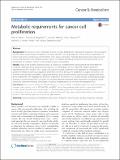| dc.contributor.author | Iliopoulos, Othon | |
| dc.contributor.author | Keibler, Mark Andrew | |
| dc.contributor.author | Wasylenko, Thomas Michael | |
| dc.contributor.author | Vander Heiden, Matthew G. | |
| dc.contributor.author | Stephanopoulos, Gregory | |
| dc.contributor.author | Kelleher, Joanne Keene | |
| dc.date.accessioned | 2018-07-11T19:57:07Z | |
| dc.date.available | 2018-07-11T19:57:07Z | |
| dc.date.issued | 2016-08 | |
| dc.date.submitted | 2016-05 | |
| dc.identifier.issn | 2049-3002 | |
| dc.identifier.uri | http://hdl.handle.net/1721.1/116916 | |
| dc.description.abstract | Background: The study of cancer metabolism has been largely dedicated to exploring the hypothesis that oncogenic transformation rewires cellular metabolism to sustain elevated rates of growth and division. Intense examination of tumors and cancer cell lines has confirmed that many cancer-associated metabolic phenotypes allow robust growth and survival; however, little attention has been given to explicitly identifying the biochemical requirements for cell proliferation in a rigorous manner in the context of cancer metabolism. Results: Using a well-studied hybridoma line as a model, we comprehensively and quantitatively enumerate the metabolic requirements for generating new biomass in mammalian cells; this indicated a large biosynthetic requirement for ATP, NADPH, NAD+, acetyl-CoA, and amino acids. Extension of this approach to serine/glycine and glutamine metabolic pathways suggested lower limits on serine and glycine catabolism to supply one-carbon unit synthesis and significant availability of glutamine-derived carbon for biosynthesis resulting from nitrogen demands alone, respectively. We integrated our biomass composition results into a flux balance analysis model, placing upper bounds on mitochondrial NADH oxidation to simulate metformin treatment; these simulations reproduced several empirically observed metabolic phenotypes, including increased reductive isocitrate dehydrogenase flux. Conclusions: Our analysis clarifies the differential needs for central carbon metabolism precursors, glutamine-derived nitrogen, and cofactors such as ATP, NADPH, and NAD+, while also providing justification for various extracellular nutrient uptake behaviors observed in tumors. Collectively, these results demonstrate how stoichiometric considerations alone can successfully predict empirically observed phenotypes and provide insight into biochemical dynamics that underlie responses to metabolic perturbations. | en_US |
| dc.description.sponsorship | National Institutes of Health (U.S.) (Grant 1R01DK075850-01) | en_US |
| dc.description.sponsorship | National Institutes of Health (U.S.) (Grant 1R01CA160458-01A1) | en_US |
| dc.publisher | BioMed Central Ltd | en_US |
| dc.relation.isversionof | http://dx.doi.org/10.1186/S40170-016-0156-6 | en_US |
| dc.rights | Creative Commons Attribution 4.0 International License | en_US |
| dc.rights.uri | http://creativecommons.org/licenses/by/4.0/ | en_US |
| dc.source | BioMedCentral | en_US |
| dc.title | Metabolic requirements for cancer cell proliferation | en_US |
| dc.type | Article | en_US |
| dc.identifier.citation | Keibler, Mark A. et al. “Metabolic Requirements for Cancer Cell Proliferation.” Cancer & Metabolism 4, 1 (August 2016): 16 © 2016 The Author(s) | en_US |
| dc.contributor.department | Massachusetts Institute of Technology. Department of Biology | en_US |
| dc.contributor.department | Massachusetts Institute of Technology. Department of Chemical Engineering | en_US |
| dc.contributor.department | Koch Institute for Integrative Cancer Research at MIT | en_US |
| dc.contributor.mitauthor | Keibler, Mark Andrew | |
| dc.contributor.mitauthor | Wasylenko, Thomas Michael | |
| dc.contributor.mitauthor | Kelleher, Joanne K | |
| dc.contributor.mitauthor | Vander Heiden, Matthew G. | |
| dc.contributor.mitauthor | Stephanopoulos, Gregory | |
| dc.relation.journal | Cancer & Metabolism | en_US |
| dc.eprint.version | Final published version | en_US |
| dc.type.uri | http://purl.org/eprint/type/JournalArticle | en_US |
| eprint.status | http://purl.org/eprint/status/PeerReviewed | en_US |
| dc.date.updated | 2018-07-11T17:45:37Z | |
| dspace.orderedauthors | Keibler, Mark A.; Wasylenko, Thomas M.; Kelleher, Joanne K.; Iliopoulos, Othon; Vander Heiden, Matthew G.; Stephanopoulos, Gregory | en_US |
| dspace.embargo.terms | N | en_US |
| dc.identifier.orcid | https://orcid.org/0000-0002-5410-6543 | |
| dc.identifier.orcid | https://orcid.org/0000-0002-8676-5738 | |
| dc.identifier.orcid | https://orcid.org/0000-0002-6702-4192 | |
| dc.identifier.orcid | https://orcid.org/0000-0001-6909-4568 | |
| mit.license | PUBLISHER_CC | en_US |
